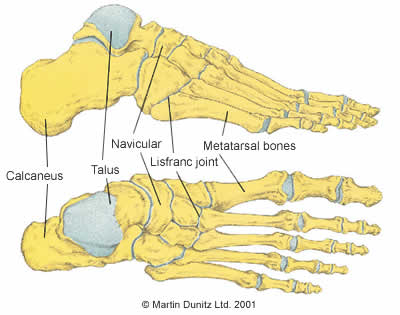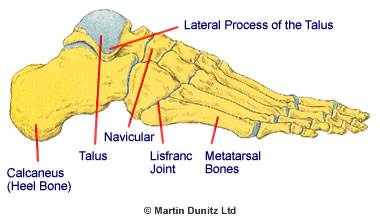| Common Signs & Symptoms | |||||
| Pain | Swelling | Stiffness | Weakness | Instability | Locking |
Metatarsal Fracture Explained
Metatarsal fractures are the most common traumatic foot injuries. Broken Metatarsals have been prominent across all professional sports in the past five years, with several high profile athletes suffering Metatarsal fractures. Professional football (soccer) players David Beckham, Wayne Rooney, Ashley Cole and Steve Gerrard have all sustained this foot injury in recent years. To understand the Metatarsal fractures further it is probably best to start by explaining the anatomy of the foot.
There are five Metatarsal bones in each foot. They are the relatively long bones which are located between the ‘Tarsal’ bones of the hind-foot and the ‘Phalanges’ bones in the toes. Functionally, the ankle and foot have two principle functions: propulsion and support. The Metatarsal bones play a major role in these functions. For propulsion they act like a rigid lever and for support they act like a flexible structure that aids balance, thus holding up the entire body.

Fractures to the Metatarsal bones can be caused by direct trauma, excessive rotational forces or overuse. During football, direct trauma is usually caused by a player accidentally kicking the sole of an opponent’s boot, or by an opponent stepping on a player’s foot. As there is very little soft tissue to protect the top of the foot, bone injuries are common. The second, third and fourth Metatarsals are the most commonly fractured with this mechanism of injury, although the fifth Metatarsal is fractured more often in soccer.
In repetitive sports like running the metatarsal bones may become overloaded and can become fractured by the stress of impact and possibly by faulty foot mechanics that cause, oftent he 5th Metatarsal to be injured in what is known as a Stress Fracture. In cycling, the pressure of cleats on the pedals can also lead to irritation and eventual fracture in a similar fashion.
The fifth Metatarsal is divided into four anatomic segments (the base, the junction of the base and the shaft, the shaft, and the neck) and different types of fracture can occur at each segment.

Fractures of the base of the fifth Metatarsal are the most common fifth Metatarsal injuries, and occur as a result of a twisting injury of the foot or ankle. The ankle rolls inward and there is a strong ligament that attaches to the base of the Metatarsal which pulls off a small bone fragment. This type of fracture is invariably treated without surgery, and immediate walking in a removable plastic cast is ideal.
The junction between the base of the Metatarsal and the shaft is the area which creates most problems when fractured. The reason for the difficulty is that bone healing relies upon a good circulation, and this particular area of the bone has a notoriously poor blood supply. Fractures of the shaft of the Metatarsal occur commonly as a result of twisting of the foot when landing from a jump, for example in ballet dancers, and these heal very rapidly with immobilisation, without any need for surgery. Landing on a hard rock or branch whilst running can also cause similar impact and injury.
Overuse can cause stress fractures of the Metatarsals. These fractures are common in army recruits as well as sporting individuals and are commonly known as ‘march’ or Stress fractures. The patient will normally report about two weeks of gradually increasing pain in the region before an incident ‘converts’ the stress fracture to a full fracture. The second Metatarsal is the most commonly affected, but the fifth Metatarsal can also be affected. While the stress fracture of the second Metatarsal usually heals well, the healing of a stress fracture to the fifth Metatarsal can be more problematic. If a Stress Fracture is caught early before it becomes a full fracture it is commonly known as a Stress response, as the excess inflammation has not yet led to a fracture and therefore holds a better prognosis. A Physiotherapist can help assess gait and identify why this area of the foot may be prone to excessive load. Corrective exercises and strengthening can then be prescribed to prevent further irritation.
Metatarsal Fracture Signs & Symptoms
There is severe and often precise foot pain with a Metatarsal fracture and the patient will usually find it difficult to walk. Often there will be pain if the fracture site is touched. A swollen foot is fairly common and bruising may be evident after a day or two.
Metatarsal Fracture Treatment
What you can do
| Consult a sports injury expert | |
| Apply ice packs/cold therapy to reduce swelling | |
| Protect the foot with a removable plastic cast | |
| Use a buoyancy aid for pool exercises | |
| Use a bone healing system to speed up broken bone healing |
If a Metatarsal fracture is suspected the patient should be transferred to an emergency department where a doctor can confirm the diagnosis by ordering an x-ray . Immediately following a Metatarsal fracture ice therapy can be effective to help with pain relief, although medication prescribed by a doctor is usually necessary. Ice Packs for a period of twenty minutes every couple of hours may help with the pain. The Aircast Ankle & Foot Cryo/Cuff is the most effective method of providing ice therapy. It can provide continuous ice cold water and compression for 6 hours and significantly reduces foot pain and swelling.
The ultimate treatment of Metatarsal fractures varies depending on the type and location of the fracture. If the fracture is due to direct trauma and the fracture fragments are well aligned then the treatment is immobilisation in a Removable Plastic Cast and non-weight bearing for 6 – 8 weeks.
The removable plastic cast is better than a plaster cast, because the boot can be removed for physiotherapy treatment, which is aimed at preventing stiffness in the ankle joint. In addition, cardiovascular fitness can be maintained by performing non-weight bearing exercises in a swimming pool using a Buoyancy Belt.
A removable plastic cast is also usually adequate for ‘march’ (stress) fractures of the second Metatarsal and rotational fractures of the fifth Metatarsal. However, stress fractures of the base of the fifth Metatarsal sometimes show a poor healing capacity. For this reason, many orthopaedic consultants now favour surgical fixation. A small incision is made on the outside border of the foot and a small screw is placed down the middle of the fractured bone. With this method a return to sporting activity is usually possible after 6 – 8 weeks.
Metatarsal Fracture Prevention
If the force applied to the foot during a traumatic incident is high then there is very little that can be done to prevent a Metatarsal fracture. However it is always important to wear appropriate footwear that gives the foot some protection and make sure you replace shoes regularly especially for activities such as running or hiking. Running shoes roughly last 500 miles so make sure you monitor this and change them to prevent inadequate shock absorption.


